Table of Contents
- What Are Lifecycle Reports?
- How Does It Work?
- Visualizations & Metrics
- Getting Started with Lifecycle Reports
- Using Lifecycle Reports
- Export and Customize Data
- Best Practices
- FAQ and Troubleshooting
- What does it mean if my conversion rate is low?
- How are skipped stages handled?
- When does a Contact’s lifecycle journey end and start over?
- Can I customize the lifecycle stages?
- My report metrics seem off. What should I do?
- How do I export data for further analysis?
- How are contact imports, bulk assignments, and stage deletions handled?
Reports: Lifecycle
 Updated
by Shing-Yi Tan
Updated
by Shing-Yi Tan
- What Are Lifecycle Reports?
- How Does It Work?
- Visualizations & Metrics
- Getting Started with Lifecycle Reports
- Using Lifecycle Reports
- Export and Customize Data
- Best Practices
- FAQ and Troubleshooting
- What does it mean if my conversion rate is low?
- How are skipped stages handled?
- When does a Contact’s lifecycle journey end and start over?
- Can I customize the lifecycle stages?
- My report metrics seem off. What should I do?
- How do I export data for further analysis?
- How are contact imports, bulk assignments, and stage deletions handled?
Lifecycle Reports help you track your Contacts’ journey from a new lead to a paying customer (or lost) by visualizing their progression through defined funnel stages. These reports answer key questions such as:
- How well is your business doing at converting new leads to paying customers?
- Where and why do contacts drop off?
- How fast are you at converting customers?
What Are Lifecycle Reports?
Lifecycle Reports are designed to give you a clear picture of your contacts’ progression through the sales or customer journey. We use a funnel model where each Contact:
- Enters the funnel: When a Contact is first assigned a lifecycle stage.
- Moves through stages: Such as New Lead, Hot Lead, Payment, and finally, the Won (or Customer) stage.
- Exits the funnel: Either by reaching the Won stage (as a paying customer), by moving into a Lost stage (drop-off), or by having their Lifecycle stage cleared (becomes empty). Once a Contact no longer has any assigned stage, they’re considered to have exited the funnel.
How Does It Work?
When Your Lifecycle Journey Starts
Once a Contact receives their very first Lifecycle stage, we start capturing their progress in all related reports. The date of that initial stage assignment is recorded as the “funnel entry” date for every metric that follows.
Every Stage Matters
Every time a contact changes stages, that movement is logged—whether they move forward, skip stages, or move backward.
Returning to the Funnel
A lifecycle journey begins the very first time a Contact is assigned any Lifecycle stage (for example, Stage 1) and ends when they ultimately reach a Won Stage or a Lost Stage. If a Contact leaves at a Lost Stage but comes back later (e.g., gets reassigned to Stage 1 again), we treat that as a new journey—complete with a new start date.
Visualizations & Metrics

Your Lifecycle Reports dashboard displays key metrics that reveal how effectively contacts move through the funnel. Here’s a breakdown of each metric and why it matters:
Overall Conversion Rate
What It Tells You:
The percentage of contacts who successfully reach the Won stage out of all contacts that entered the funnel.
Why It Matters:
- Indicates the health and effectiveness of your sales process.
- Helps identify if certain stages are causing major drop-offs.
Example:
If 100 contacts enter the funnel and 40 reach the Won stage, your overall conversion rate is 40%.
Average Time to Conversion
What It Tells You:
How long (on average) it takes for a contact to go from funnel entry to Won stage.
Why It Matters:
- Helps you forecast sales cycles and adjust engagement strategies.
- Reveals opportunities to streamline processes and shorten the sales cycle.
Example:
If Contact A converts in 2 days, Contact B in 4 days, and Contact C in 6 days, the average time to conversion is 4 days.
Overall Drop-Off Rate
What It Tells You:
The percentage of contacts that end up in any Lost stage rather than converting.
Why It Matters:
- Highlights where leads disengage or abandon the process.
- Allows you to pinpoint bottlenecks and take targeted actions (e.g., re-engagement strategies).
Example:
If 100 contacts enter the funnel and 30 move to a Lost stage, the drop-off rate is 30%.
Average Time to Drop-Off
What It Tells You:
The average time it takes for a contact to exit the funnel by reaching a Lost stage.
Why It Matters:
- Pinpoints if drop-offs happen early or later in the funnel.
- Informs where you should adjust messaging, resources, or follow-up timing.
Example:
- If on average contacts drop off 2 days after first entering the funnel, you know early-stage engagement needs improvement.
- Conversely, if the average time to drop off is very long, your team may be dedicating excessive time and effort to leads that ultimately don’t convert, signaling a potential need for more efficient qualification or nurturing strategies.
Getting Started with Lifecycle Reports
To start using Lifecycle Reports, follow these practical steps:
1. Enable the Lifecycle Feature
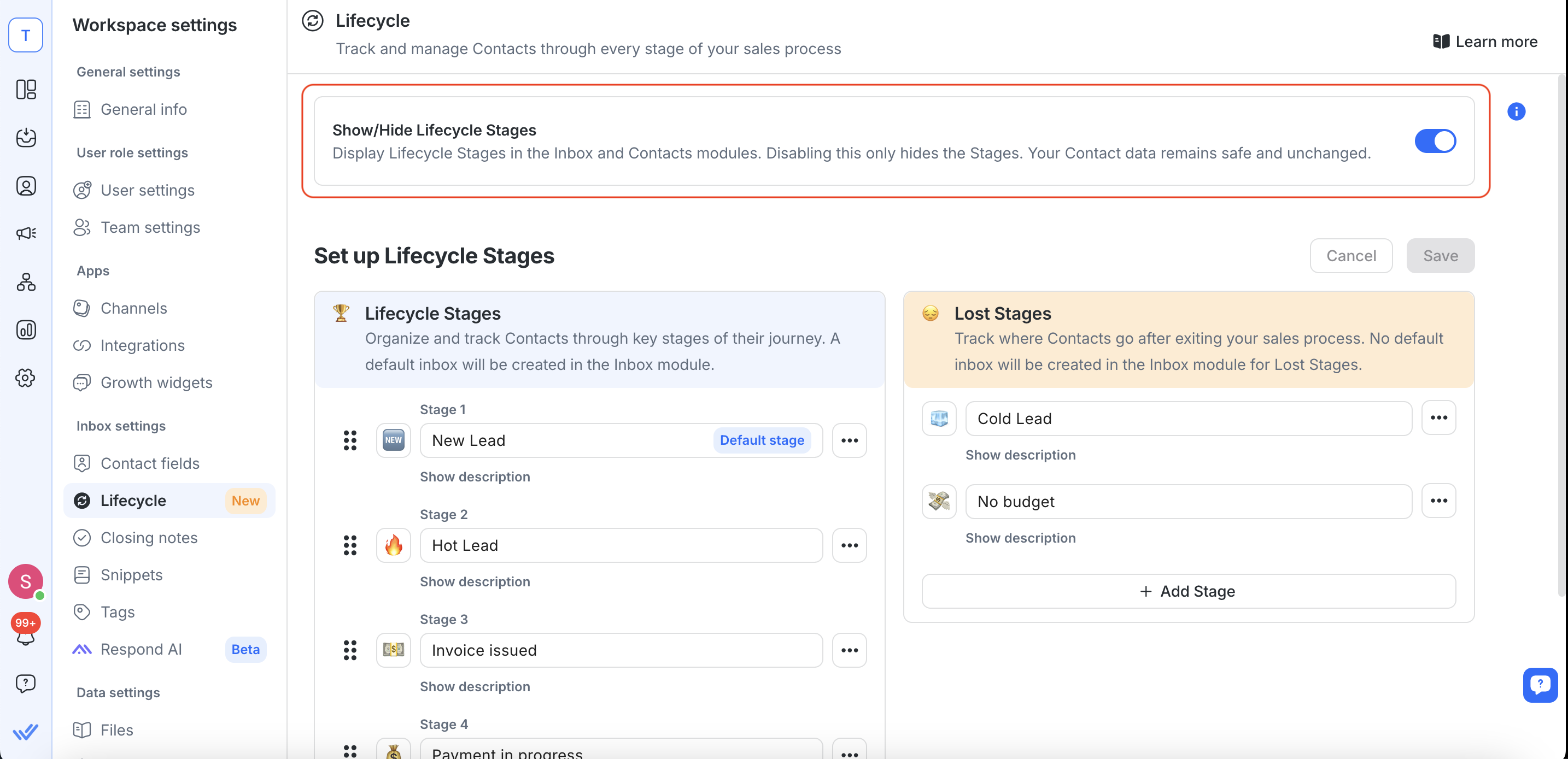
- Navigate to your workspace settings.
- If Lifecycle is not enabled, turn on the Show/Hide Lifecycle Stages toggle to enable it.
2. Access the Reports Module
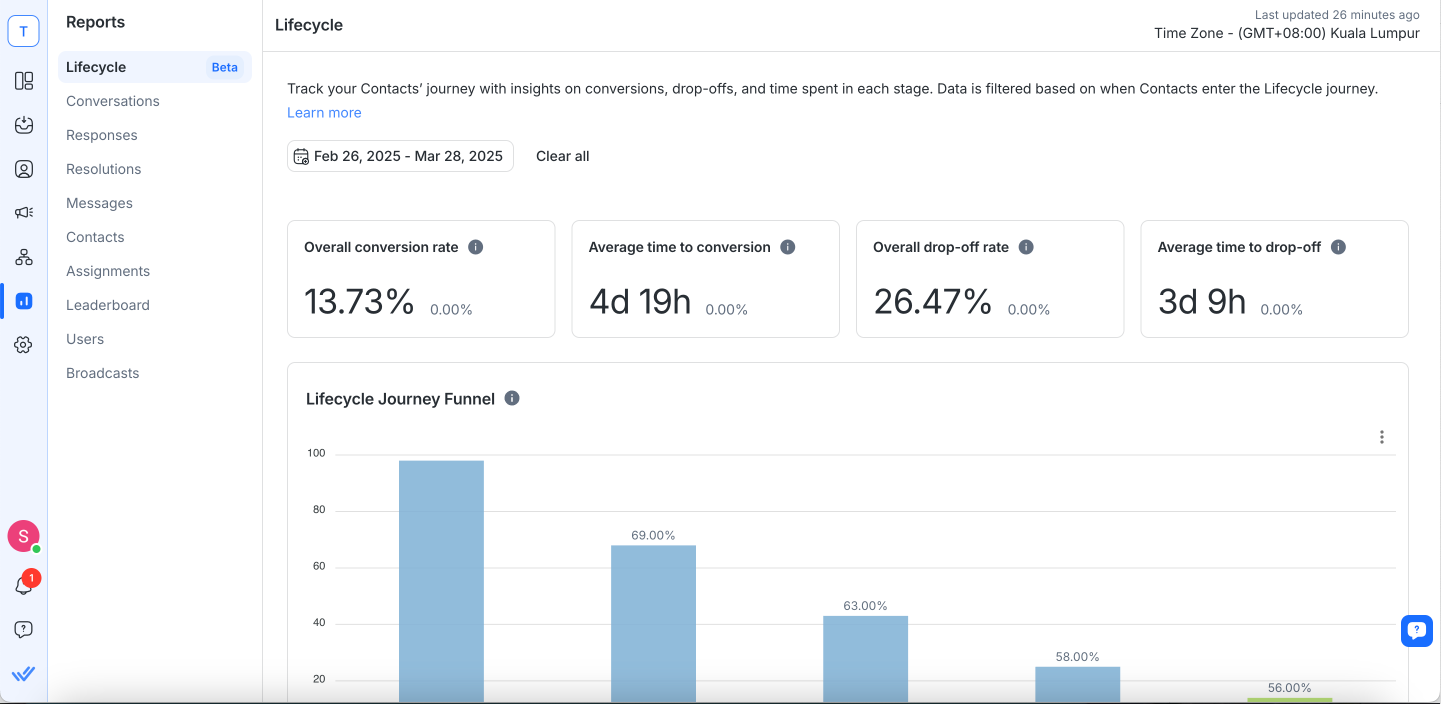
- Once Lifecycle is active, go to the Reports section and select Lifecycle.
- The Lifecycle report page will default to a pre-selected date range (e.g., the last 14 days).
3. Configure Date Filters
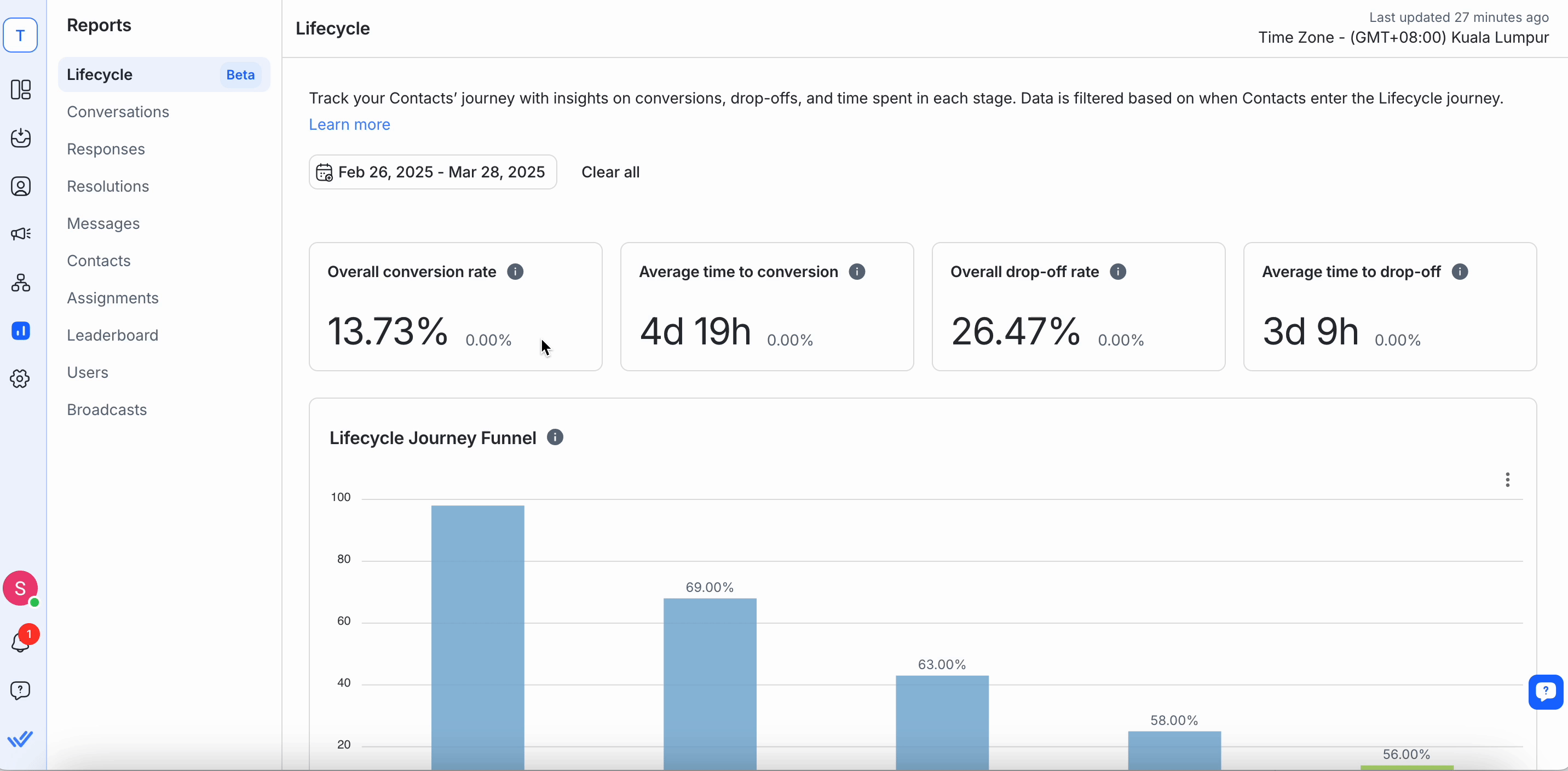
- Use the Date Picker to choose when contacts first entered a lifecycle stage. Only those who began their lifecycle journey during this period are included in the report.
- Options include Today, Yesterday, Last 7 Days, Last 14 Days, Last 30 Days, etc.
4. Review and Interpret Metrics
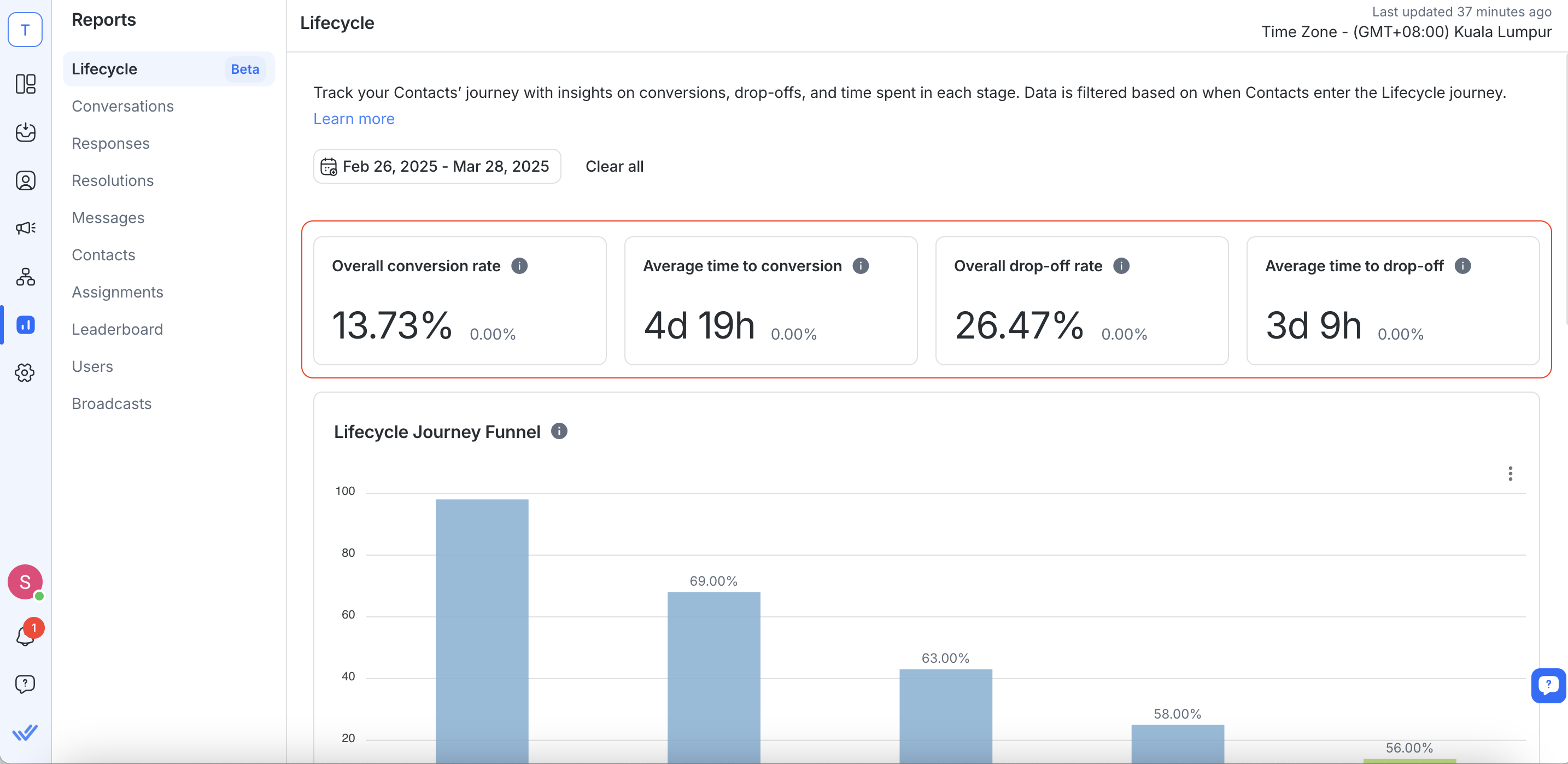
- Study the conversion and drop-off metrics on the dashboard.
- Hover over charts and cards for callouts that explain each metric in detail.
Using Lifecycle Reports
After setting up, here’s how you can use Lifecycle Reports to optimize your business:
Monitor Conversion and Drop-Off Rates
- Review the overall conversion and drop-off rates to assess your sales performance.
- Compare current metrics with previous periods (using percentage differences) to gauge trends.
Locate and Understand Your Drop-Off Points
- Identify Where They Drop Off: The report shows which stage contacts exit from, helping you pinpoint the exact point in your funnel where leads are disengaging.
- Understand Why They Drop Off: By reviewing destination Lost stages (e.g., “No Budget,” “Not Interested,” etc.), you gain clarity on the most common reasons for lost opportunities.
- Actionable Insights: If a significant number of contacts drop off from Stage 2 with “No Budget,” you can refine your qualification process or tailor outreach strategies to address that specific objection. This targeted approach helps reduce overall drop-offs and improves funnel efficiency.
Analyze Time-to-Conversion and Time-to-Drop-Off
- Identify how long contacts remain idle in each stage.
- Use these insights to determine if your follow-up strategies are effective or if certain stages need improvement.
Leverage Visualizations
The Lifecycle Journey Funnel graph shows you the number of contacts at each stage.
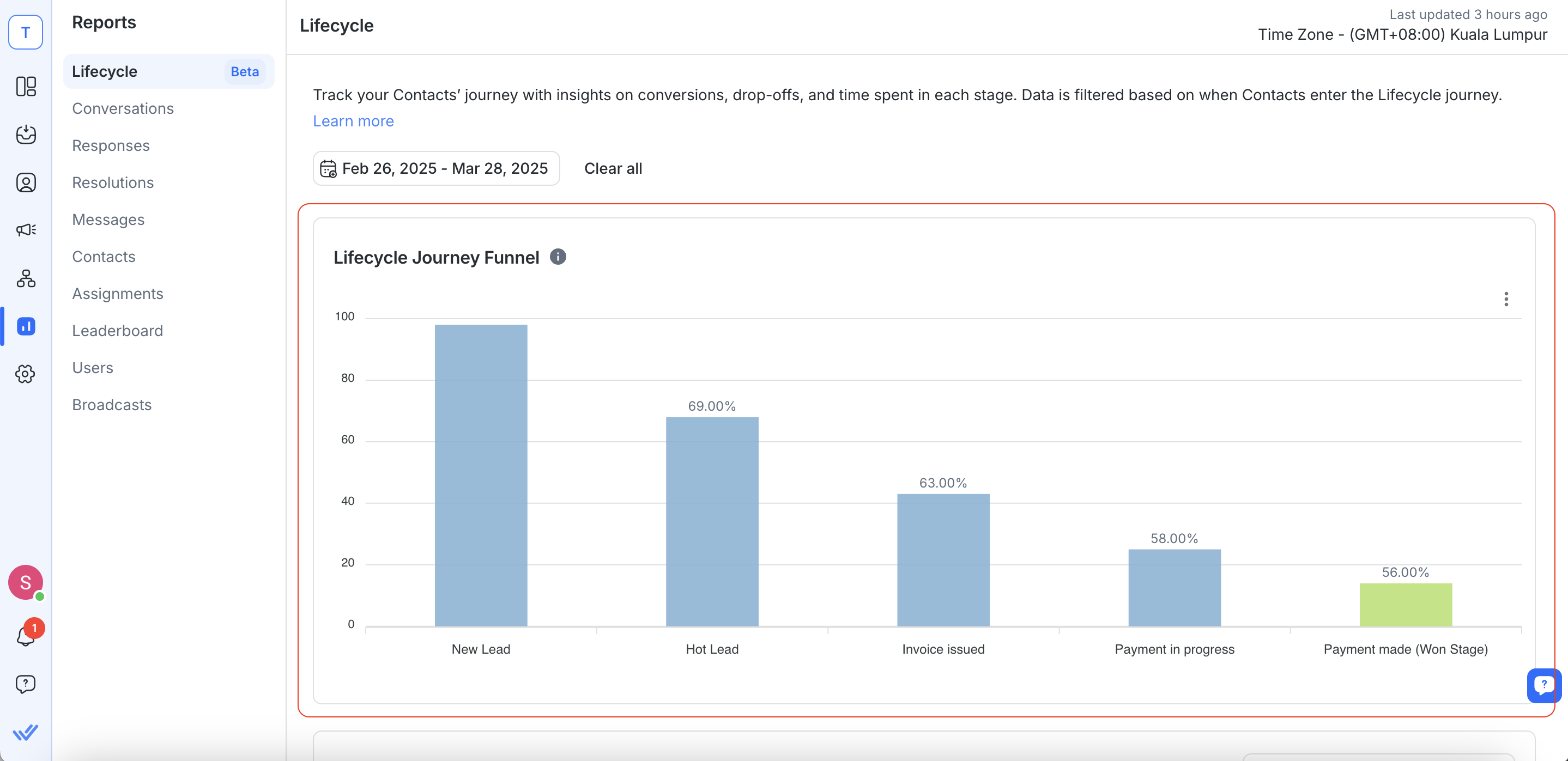
The Lost Stages Breakdown chart helps you pinpoint which lost stages are most common.
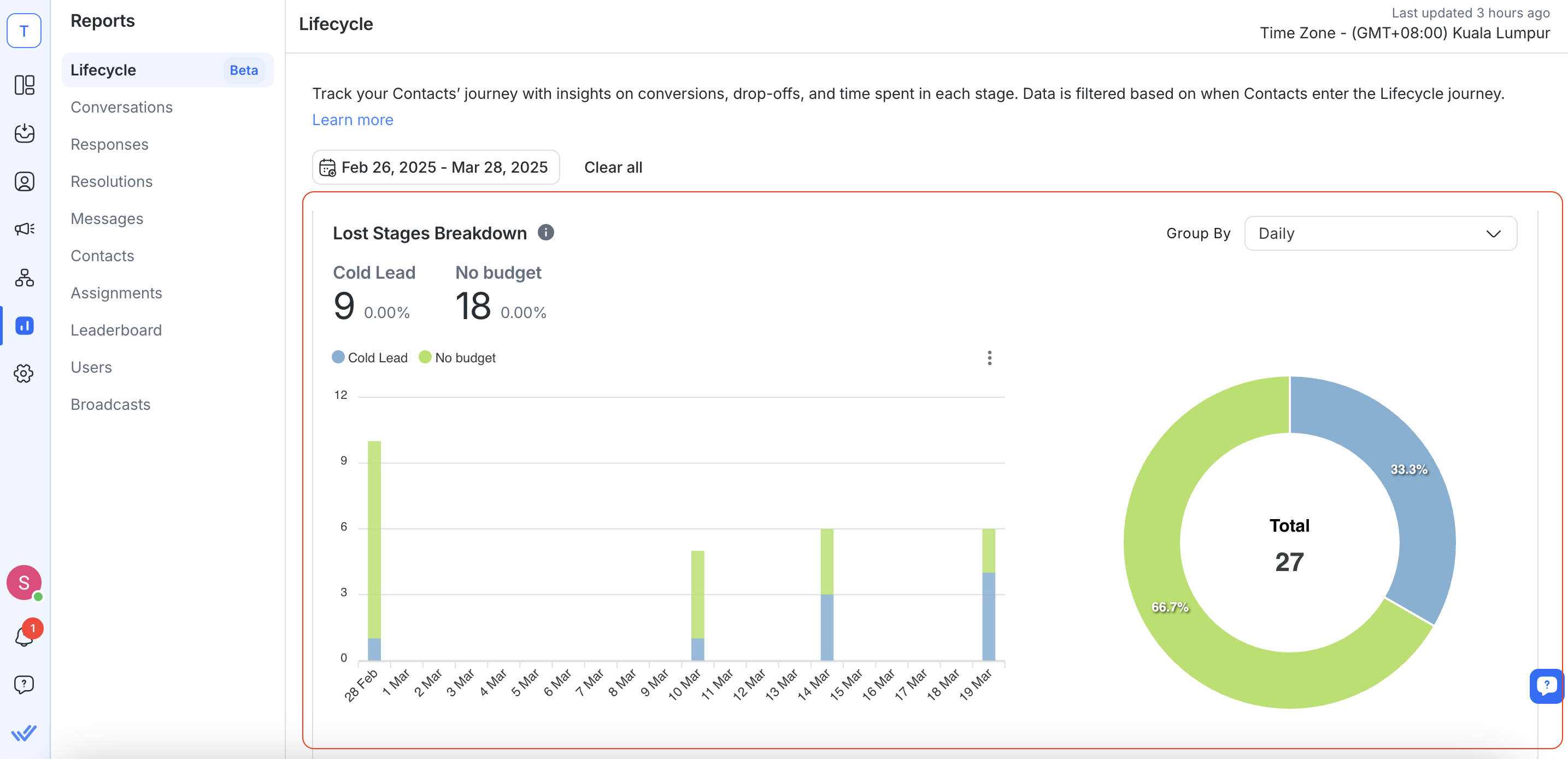
A detailed Breakdown Table offers granular data on:
- Conversion rates per stage
- Average time spent in each stage
- Drop-off destinations (which Lost Stage contacts move to)
- Common drop-off reasons (e.g., “No Budget,” “Not Interested”)
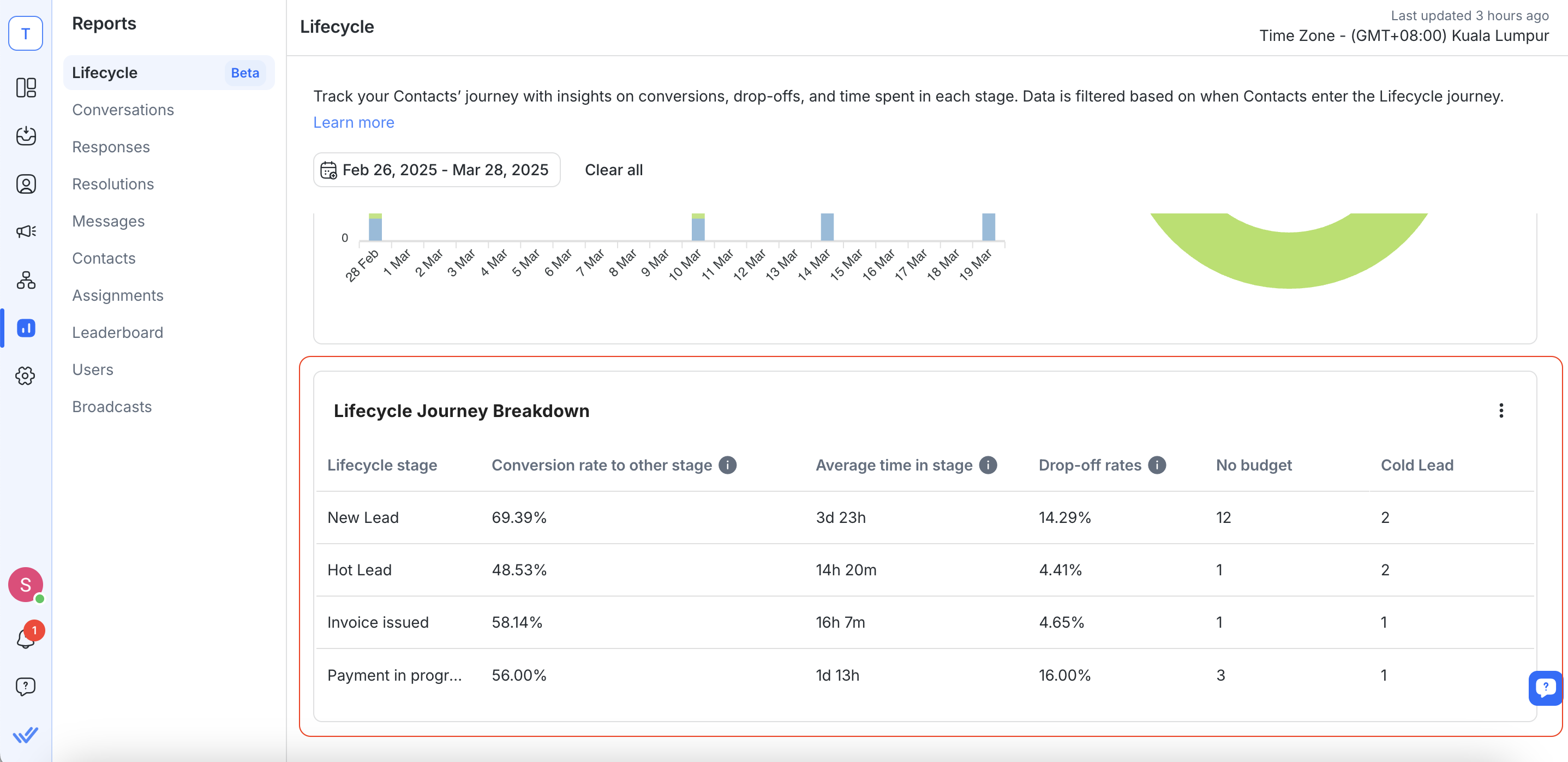
Export and Customize Data
Use built-in options to export data to CSV or customize the columns as needed for further analysis.
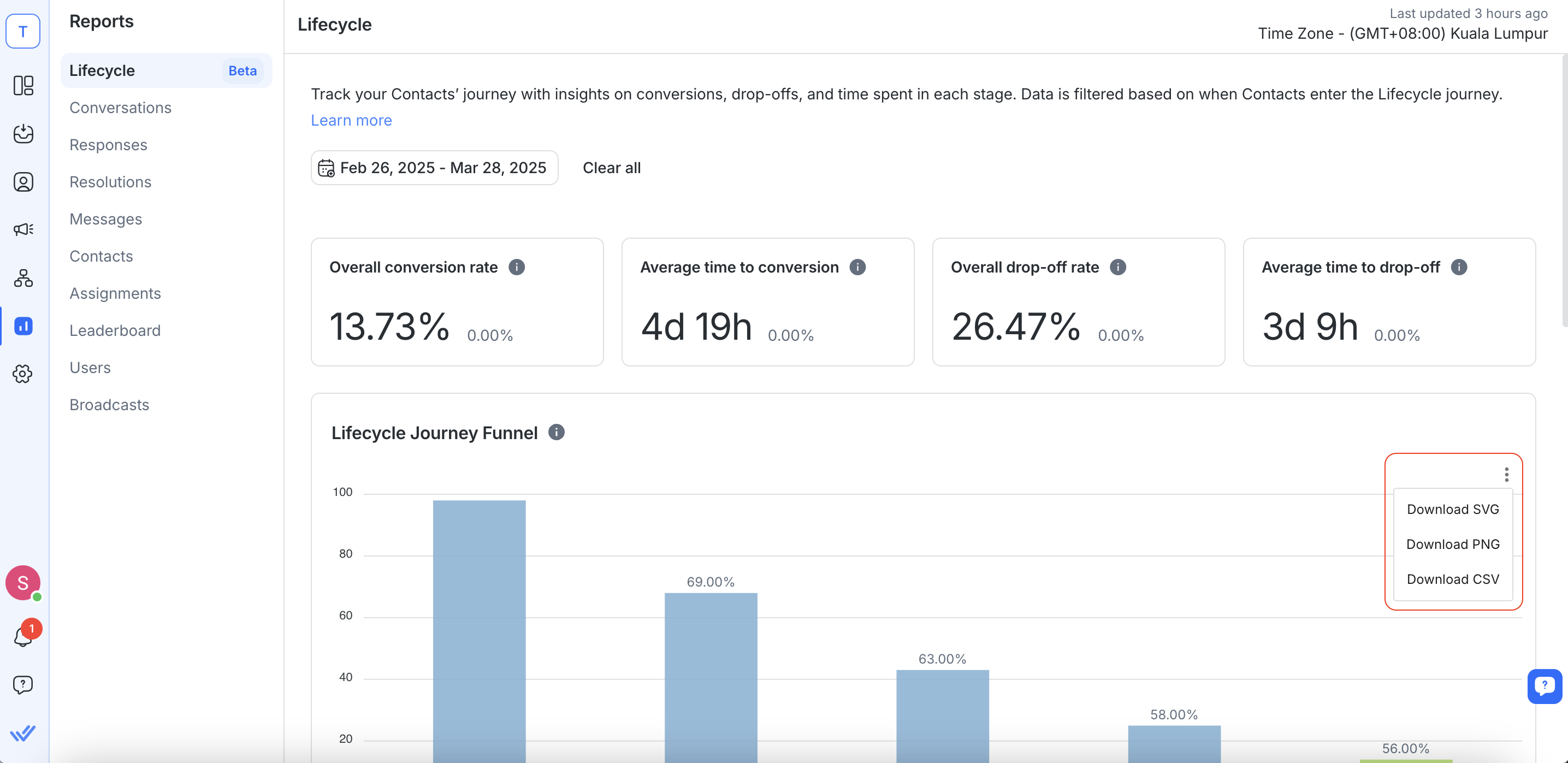
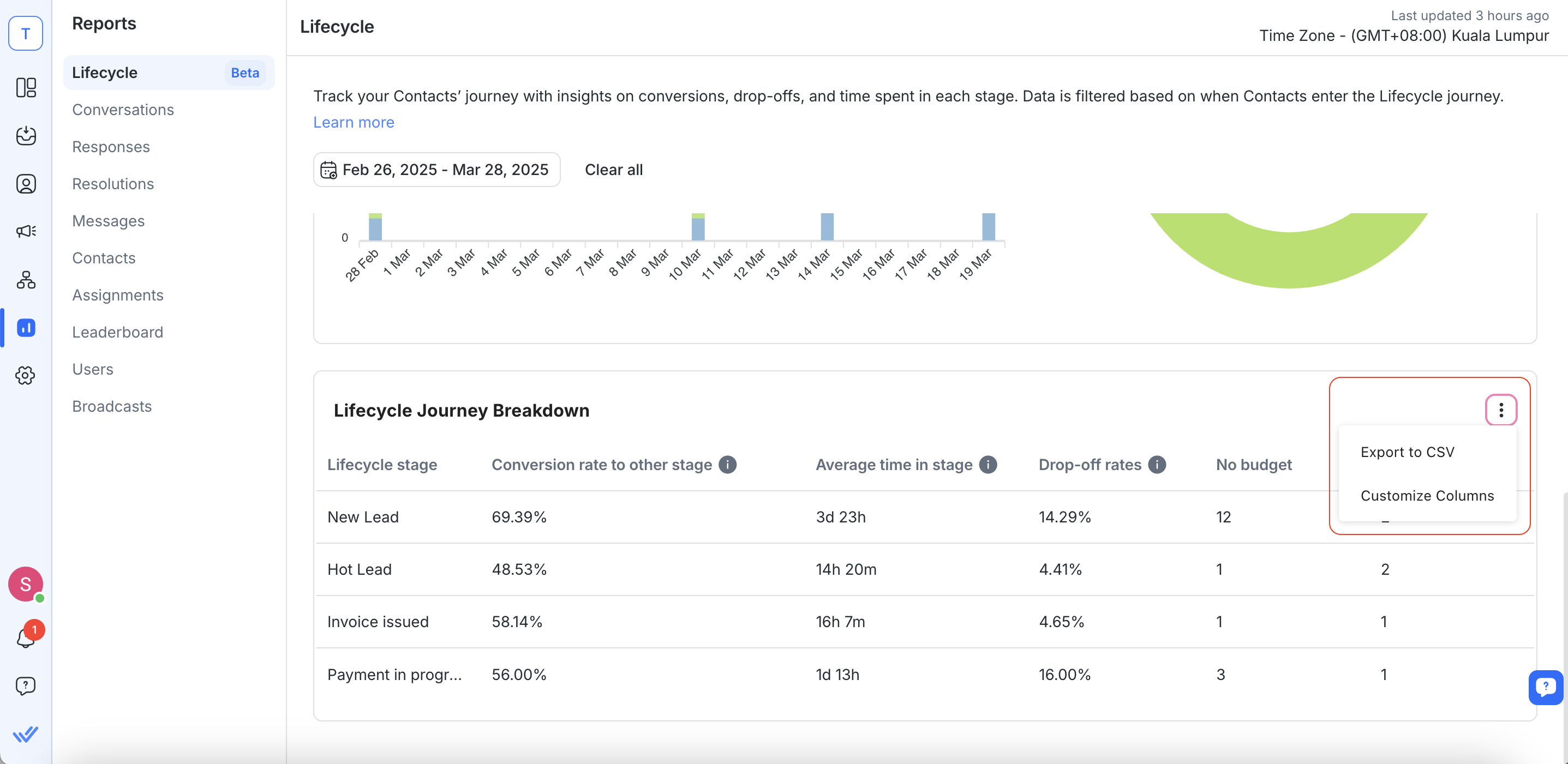
Best Practices
Limit Stage Changes
Try not to frequently add, delete, or rearrange lifecycle stages unless necessary. Drastic or repeated changes in stage configuration can disrupt data consistency and affect the accuracy of your reports.
Keep Your Data Updated
Regularly update contact statuses and lifecycle stages. Inaccurate data can skew conversion and drop-off metrics.
Use Default Stages Correctly
Avoid modifying or deleting critical stages like the Won stage. These stages are essential for accurate metric calculations.
Regularly Review Trends
Monitor changes over different date ranges. This can help identify if a campaign is improving conversion speed or if there are persistent drop-offs in specific stages.
Train Your Team
Ensure that everyone responsible for updating contact details understands the importance of logging proper lifecycle transitions.
FAQ and Troubleshooting
What does it mean if my conversion rate is low?
A low conversion rate indicates that fewer contacts are moving from the initial stages to the Won stage. This may suggest that your follow-up process or lead nurturing strategy needs improvement.
- Review the stages where contacts are stalling. If a particular stage has both a low conversion rate and a low drop-off rate, it often means contacts are getting stuck there without progressing or exiting.
- Check if there are any process bottlenecks or if leads are not being followed up in a timely manner.
How are skipped stages handled?
If a contact bypasses one or more stages and goes directly to a later stage (e.g., directly to the Won or Lost stage), the system treats the movement as a skip. The skipped stages movements are logged in the background to ensure accurate funnel calculations but are excluded from certain time-based metrics.
When does a Contact’s lifecycle journey end and start over?
A Contact’s Lifecycle journey ends the moment they move into a Won stage, a Lost stage, or a cleared (no stage) state. If they later move out of these states and back into a main stage, it’s considered a new journey. This ensures that all subsequent lifecycle movements are captured independently, starting with a fresh funnel entry date.
- Confirm that reentered contacts are correctly logged with a new funnel entry date.
- Verify that any reengagement strategies are properly documented so you can track improvements over multiple journeys
Can I customize the lifecycle stages?
Yes, you can add new stages (which will appear before the Won stage) and update stage names or descriptions. However, certain stages (like the Won stage) are locked from deletion or movement to maintain reporting accuracy.
- Limit Stage Modifications: Frequent or extensive changes (adding, deleting, or reordering) can temporarily cause data inconsistencies, so it’s best to only alter stages when it’s absolutely necessary.
- Check Metrics After Changes: If data seems off following a customization, verify that the new stage has been properly integrated and allow some time for the system to stabilize.
- Maintain Consistency: Keep in mind that the more consistent your lifecycle configuration remains, the more reliable and accurate your reports will be over time.
My report metrics seem off. What should I do?
If the metrics (such as conversion or drop-off rates) appear inaccurate:
- Check Contact Assignments: Verify that all contacts are being assigned the correct stages.
- Review Date Filters: Ensure your date filters are set properly and reflect the period you want to measure.
- Look for Anomalies in Logs: Inspect the logging history to see if there are sudden spikes or drops in contact counts that might indicate data-entry errors.
- Account for Recent Stage Changes: If you recently added, deleted, or rearranged any lifecycle stages, the data may appear inconsistent for a short period. It’s best to wait for the data to “cool down”—in other words, allow the system to gather enough new, consistent data under your updated configuration—before drawing conclusions.
How do I export data for further analysis?
You can use the export option available in the breakdown tables (accessed via the kebab menu). This lets you download the report data as a CSV file.
- Ensure your browser pop-up blocker is disabled when initiating the export.
- If the export fails, try refreshing the page or using a different browser.
How are contact imports, bulk assignments, and stage deletions handled?
Bulk Imports & Assignments:
When contacts are imported or assigned a stage in bulk, the system does not log that action as an “active transition.”
- Example: If a contact is in Stage 1 and then bulk-updated to Stage 2 via import, followed later by a user manually updating that same contact to Stage 3, only the Stage 2 → Stage 3 change is recorded as a lifecycle movement. The import-related update (Stage 1 → Stage 2) is not logged.
Stage Deletions:
Removing a lifecycle stage can temporarily skew your metrics, especially if many contacts were assigned to that stage — because all movements to and from that stage are deleted from the logs and no longer appear in reports. After a deletion, you may see unusual data until the system stabilizes with the new stage configuration.
- Recommended Steps:
- Verify Post-Import Updates – If imported contacts appear to distort your metrics, check that any manual or automated updates afterward are properly logged.
- Minimize Large-Scale Stage Changes – Frequent additions, deletions, or re-sequencing of stages can lead to inconsistent data.
- Allow a “Cooling Period” – If you do make significant stage changes or bulk imports, let the data settle before drawing conclusions about your metrics.
